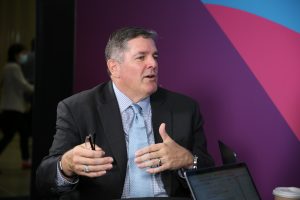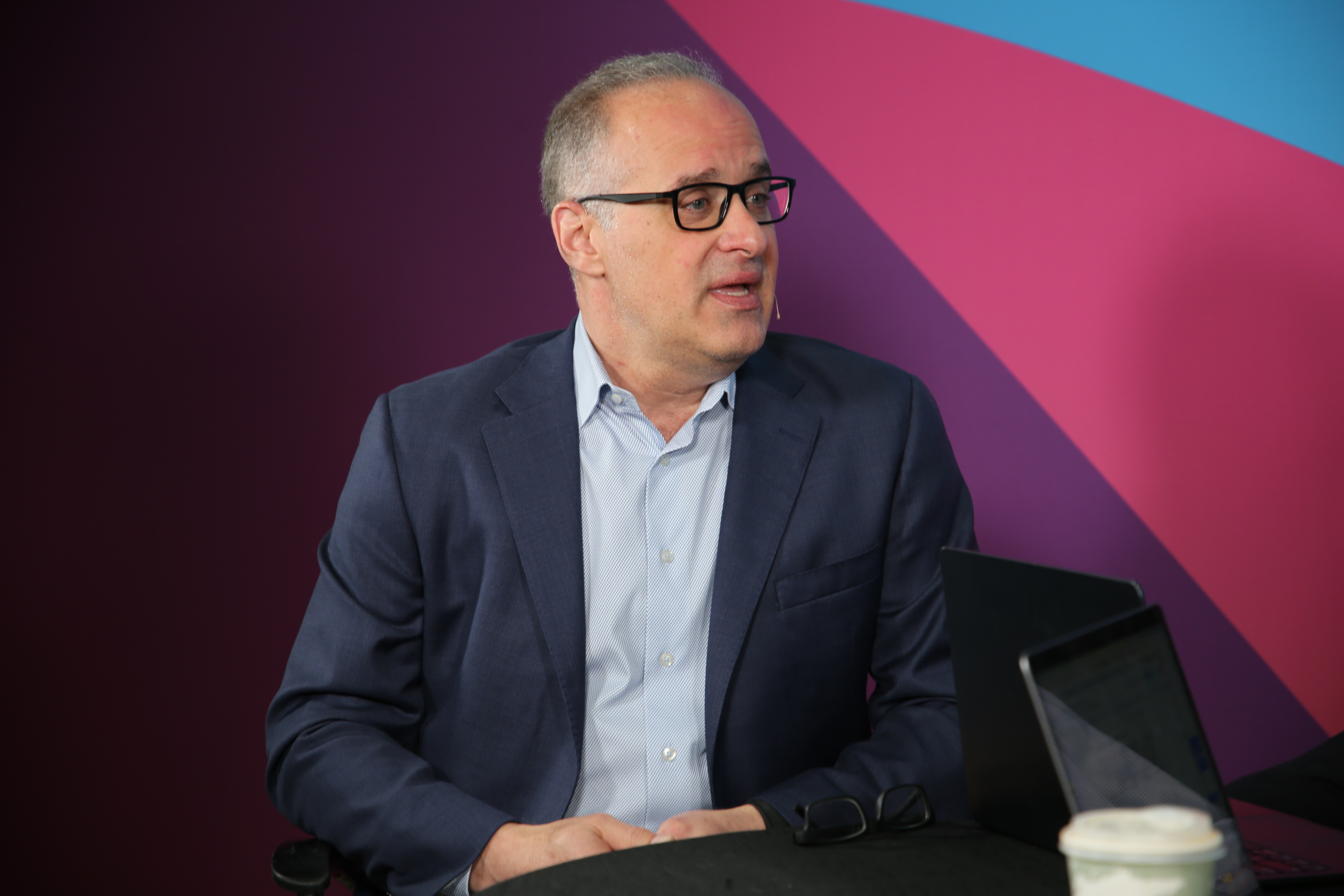Public sector transformation is entering a critical phase, driven by the rise of agentic AI and digital labor that doesn’t just automate, it adapts. But the biggest obstacle isn’t the technology. It’s the systems, silos and culture built for a slower, pre-AI world.
TheCUBE’s John Furrier discusses public sector transformation.
What’s really holding back progress in the public sector isn’t a lack of innovation — it’s the difficulty of adoption. From aging infrastructure to deeply rooted bureaucracies, systemic inertia remains the biggest obstacle. Meanwhile, AI is rapidly reshaping the role of government, raising the stakes for timely transformation, according to theCUBE’s John Furrier.
“If you’re in the public sector and you are not leveraging AI, you’ll be out of business,” he said.
During the AWS Summit, Washington DC, Furrier and Scott Hebner explored how agentic AI, cloud infrastructure and cultural change are converging to drive public sector transformation, with insights from leaders at Amazon Web Services Inc., Salesforce Inc., Snowflake Inc. and more on overcoming systemic barriers and modernizing government operations. (* Disclosure below.)
1. Public sector transformation demands product leadership and AI fluency
Government agencies face a growing disconnect between rapid technological advancement and slow-moving institutional processes. As AI systems become more agentic and capable, the need to modernize workflows, consolidate data silos and reimagine service delivery becomes urgent. Transformation is no longer optional, it is foundational to future-readiness, according to Furrier.
To succeed, public sector institutions must adopt new leadership models centered on product thinking and domain expertise. The next generation of public servants will need to bring together policy knowledge and technical literacy to bridge legacy systems with modern capabilities. This convergence could unlock scalable, citizen-centric solutions that meet the speed and complexity of today’s demands, Hebner added.
Read more of theCUBE’s exclusive event analysis.
2. Amazon’s AI strategy blends physical and digital defense
Amazon.com Inc.’s approach to AI-powered security reflects the future of public sector transformation, where physical and digital systems are inseparable. As threats evolve, Amazon is leveraging AI agents to proactively test, defend and harden its infrastructure at scale. These agents simulate attacks and generate real-time signatures that help prevent breaches across systems.
The adaptability and automation in securing both data centers and critical infrastructure is important, according to Steve Schmidt (pictured), senior vice president and chief security officer at Amazon. From smart robotics to satellite networks, AI is no longer just supporting operations — it’s defining them. The shift toward intelligent tooling and secure-by-default systems will play a pivotal role in reshaping how the public sector protects itself.
Check out theCUBE’s complete interview.
3. Snowflake brings AI capabilities to the data in public sector
Public sector transformation is accelerating as agencies adopt new approaches to data and AI integration. Instead of moving data to capabilities, the shift now is bringing capabilities to where the data already lives, explained Tim Tutt, general manager of public sector at Snowflake. This approach reduces complexity, speeds deployment and enhances security and trust from the start.
Snowflake’s focus on interoperability and low-latency access is helping defense and national security teams operate more effectively at the tactical edge. With IL5 certification and a growing partner ecosystem, Snowflake is enabling mission-critical workloads while maintaining compliance and agility. This data-first model is reshaping how agencies build and deploy AI-powered solutions.
Watch the full interview from theCUBE.
4. AWS scales data infrastructure to power AI and sustainability goals

AWS’ Kevin Miller talks to theCUBE about modern AI infrastructure.
AWS is redefining what modern infrastructure means in the age of AI, investing billions into intelligent data centers that are smarter, greener and built for global scale. Kevin Miller, VP of global data centers at AWS, outlined how innovations such as liquid cooling, recycled water and modular nuclear reactors are changing the economics and the environmental footprint of cloud expansion.
This approach is already influencing public sector transformation, as AWS partners with governments to bring data infrastructure to rural regions and mission-critical environments. With advanced AI systems being used to optimize operations and accelerate decision-making, AWS is setting the pace for a new era of agile, sustainable public-private infrastructure development.
Read the full story on theCUBE.
5. AWS CISO Circles foster collaboration in the age of AI
Public sector transformation is benefiting from a unique kind of trust network: AWS CISO Circles. This global program fosters candid, NDA-protected conversations among cybersecurity leaders, explained Danielle Ruderman, worldwide security specialist at AWS. These peer-to-peer exchanges help CISOs navigate AI adoption, regulatory demands and organizational change at speed.
By sharing strategies across industries, participants are bridging gaps in knowledge, influence and risk management. Ruderman’s team encourages community-led collaboration to address shared challenges, whether scaling a culture of security or preparing for sovereign cloud mandates. These trusted cohorts are redefining how innovation and security move forward, together.
Don’t miss the full interview on theCUBE.
6. Salesforce’s vision for AI-powered government gains traction
Salesforce is doubling down on its public sector transformation strategy, bringing AI directly into the flow of work across federal agencies. With the launch of Agentforce and its FedRAMP High accreditation, the company is enabling secure, scalable adoption of AI agents capable of supporting complex tasks, such as grant approvals and KPI monitoring. This marks a major milestone in making AI not just accessible, but actionable for government missions, according to Mia Jordan, industry advisor for public sector transformation at Salesforce.
Cultural change is central to this transformation. As agencies adapt to new models of digital labor, embedded intelligence is becoming a cornerstone of productivity. Salesforce’s approach, which focuses on upskilling through daily use and seamless integration, encourages governments to shift from reactive operations to proactive, data-informed services. Jordan emphasized that AI must be integrated within existing platforms, not bolted on, if it’s going to truly drive meaningful change.
Watch theCUBE’s full sit-down.
7. How AWS community leaders are building trust, tech skills and pride in place

AWS’ Sarah Georgiades talks to theCUBE about the company’s community outreach programs.
Public sector transformation isn’t just about digital infrastructure, it’s about social infrastructure, too. Sarah Georgiades, head of community relations and affairs for data center infrastructure at AWS, leads efforts to ensure the company’s investments are felt far beyond the fence line. Her team works with local schools, nonprofits and community leaders to strengthen education, close opportunity gaps and foster long-term partnerships that grow alongside the regions AWS supports.
From STEM vans in Northern Virginia to custom-built programs in agriculture-driven Oregon, Georgiades’ team tailors outreach to meet each community’s unique needs. Rather than imposing a one-size-fits-all model, AWS leans into local identity and invests in sustainable impact that aligns with regional values. This people-first strategy grounds big tech expansion in trust, collaboration and real-world outcomes that inspire the next generation of builders.
Check out theCUBE’s complete interview.
8. Why AWS is investing billions in AI-powered government infrastructure
Public sector transformation increasingly depends on how well governments and cloud providers align on three critical fronts: AI policy, energy availability and scalable infrastructure. Shannon Kellogg, VP of public policy, Americas, at Amazon, shared that AWS is making strategic investments in regions such as North Carolina and Pennsylvania, not just for location, but for energy access, regulatory support and long-term AI growth.
Data center expansion is no longer just a technical decision; it’s deeply tied to policy and permitting innovation at the federal and state levels, according to Kellogg. With $30 billion committed across two states, AWS is helping shape a future where energy resilience, infrastructure efficiency and AI development go hand-in-hand to power the next wave of government modernization.
Watch the full interview from theCUBE.
9. Public safety meets AI: CentralSquare’s modernization play
AI and operational efficiency are reshaping how public agencies deliver essential services. Kirk Cameron, chief technology officer of CentralSquare Technologies, shared how agentic AI and cloud infrastructure are streamlining processes from 911 dispatch to utility billing, enabling faster, more secure service without requiring large IT investments.
Modernizing public safety workflows, Cameron noted, goes beyond automation. It’s about empowering teams to focus on their core missions while minimizing administrative burdens. With cloud-native tools and integrated systems, CentralSquare is helping smaller municipalities scale smartly and respond more effectively.
Hear the full story on theCUBE.
10. AWS builds deeper roots to drive long-term public sector transformation

AWS’ Roger Whener talks about how AWS’ long-term partnerships are transforming local economies.
Public sector transformation is no longer just about data centers, it’s about long-term partnerships that reshape local economies. Roger Wehner, VP of economic development at AWS, leads a team that works directly with communities to align infrastructure investments with local needs, from workforce development to sustainability and education. AWS takes a marriage-like approach, embedding into communities and co-investing in regional solutions, rather than treating expansions as transactional builds.
One key focus is preparing the next generation of tech workers through middle school STEM programs and apprenticeship tracks such as the four-week GPA course. By exposing learners to real-world jobs in data operations, HVAC and cabling, AWS helps create clear, attainable career paths. From coding bootcamps to food trucks becoming restaurants, the ripple effects go well beyond infrastructure, delivering cultural and economic renewal that doesn’t always fit on a spreadsheet, but shapes futures all the same.
Don’t miss the full interview on theCUBE.
11. Why Caylent believes agentic AI is the future of public services
AI is no longer a future goal for government; it’s fast becoming the operational backbone. Valerie Henderson, president of Caylent Inc., sees public sector transformation accelerating as generative and agentic AI move from experiments to embedded, production-ready systems. With Bedrock and SageMaker, agencies can deploy smarter workflows, faster diagnostics and next-gen user experiences across sectors such as healthcare, higher ed and manufacturing.
True transformation isn’t just technical, it’s cultural, Henderson emphasized. Caylent helps agencies rethink legacy database strategy, stand up co-pilots for regulated industries and build durable change management frameworks for digital labor. As AI evolves from automation to decision-making, the emphasis shifts toward domain-specific models, faster time-to-value and outcomes that reshape how services are delivered.
Watch theCUBE’s full sit-down.
Here’s the complete video playlist from News’s and theCUBE’s coverage of AWS Summit Washington, DC:
https://www.youtube.com/watch?v=videoseries
(* Disclosure: TheCUBE is a paid media partner for the AWS Summit Washington, DC event. Neither Amazon Web Services Inc., the sponsor of theCUBE’s event coverage, nor other sponsors have editorial control over content on theCUBE or News.)
Photo: News
Your vote of support is important to us and it helps us keep the content FREE.
One click below supports our mission to provide free, deep, and relevant content.
Join our community on YouTube
Join the community that includes more than 15,000 #CubeAlumni experts, including Amazon.com CEO Andy Jassy, Dell Technologies founder and CEO Michael Dell, Intel CEO Pat Gelsinger, and many more luminaries and experts.
THANK YOU










